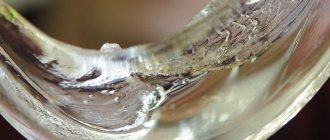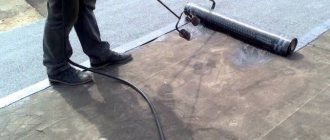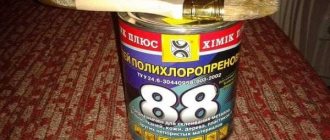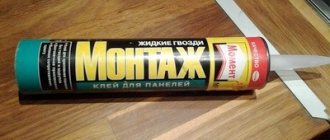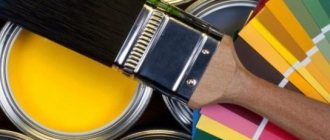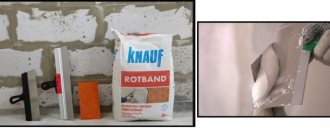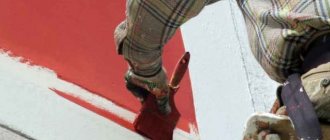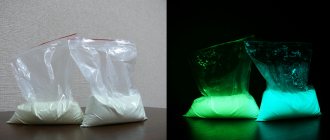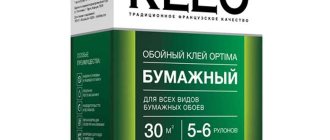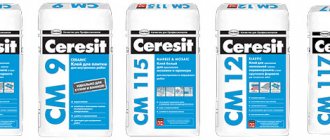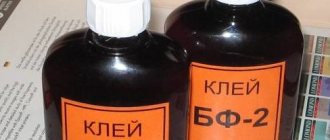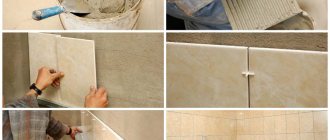What should a quality product be like?
To ensure that the glued paper product retains its original appearance for a long time and the joint is not damaged, you need to use only high-quality, reliable products. A good paper glue must meet the following requirements:
- Optimal consistency. Compositions that are too thick are difficult to apply; liquid ones can saturate and deform the paper.
- Sufficient shelf life. If the glue is damaged, it will begin to separate, form clumps, and lose its adhesion to the surface.
- No chemical smell. Most paper work is done indoors, many of them by children, so the adhesive must be safe.
- Ease of application. The product in an aerosol, with a convenient spout, is easier and faster to apply, and the accuracy of the work will significantly increase. For adhesives in large jars, you will have to purchase additional brushes.
- Colorless after drying. If the glue turns yellowish or white as it dries, it will be noticeable on the surface of paper products and can ruin them.
Equipment for applying hot-melt adhesive for cardboard
| Name | Glue type | Short description | Viscosity, mPa.s |
| Hot glue gun BUHNEN HB-181 | Manual hot glue gun for applying hot glue in pins. | ||
| Hot glue gun BUHNEN HB-195 | Manual hot glue gun for applying hot glue in pins. | ||
| Hot glue gun BUHNEN HB-250 | Glue gun HB250 | ||
| Hot glue gun BUHNEN HB-191 | Manual hot glue gun for applying hot glue in pins. | ||
| Hot glue gun BUHNEN HB 710 spray | Provides the ability to apply glue by spraying with precise temperature and volume settings. Flexibility is provided by the additional mode of applying glue in strips. | ||
| Pneumatic hot glue applicator BUHNEN HB 710 Bead | The HB 710 electronically controlled hot melt adhesive applicator sets the standard for professional air-powered manual hot melt adhesive guns. Suitable for applying glue in dots and stripes. |
Types of glue for gluing paper and cardboard
Depending on the composition, there are several types of adhesives that are well suited for working with paper.
Glue stick
This glue is the most popular in children's art and is widely used in schools and kindergartens due to its ease of use and the absence of stains on hands. The bottle of glue is compact, easy to hold in your hand, the product is affordable, and is sold everywhere. The glue stick has a fairly thick consistency, is economical in use, and successfully glues paper, cardboard, and textiles. Other advantages are the absence of deformation of the paper from the glue and the possibility of applying it in an even, thin layer. This product leaves no traces at all.
The disadvantage of a glue stick is significant - the gluing area will not last long and after a few days it may begin to lose strength. It is recommended to use adhesive pencils for temporary fastening of paper and connecting small parts, for example, when gluing an applique to a sheet. It is better not to fasten bulky items, as well as complex seams and joints - they will separate from each other almost immediately.
PVA
Polyvinyl acetate (PVA)-based glue is well suited even for thick paper and cardboard, as it has excellent adhesion. In addition, with the help of PVA, applications are created from natural materials, fabric, feathers, and threads. High-quality glue is thick, white, but after drying it becomes almost transparent and does not turn yellow. It has a mild odor and is completely harmless to humans.
PVA is easy to spread over the base and does not deform the paper, although it should be applied in a minimal layer to the thinnest sheets. It is usually available in small soft bottles with a brush or thin nozzle. You should not leave the package without a cap for a long time: the product dries out quickly, and a dense “plug” may form in the dispenser, which will have to be removed. The glue sets in 3-5 minutes, but dries completely within a day.
Super glue
Such products are made on the basis of cyanoacrylate and have the highest adhesive force, which reaches its maximum on thin and porous materials. Superglues include the familiar “Moment”, “Second” and many other brands. Using the products you can glue paper and cardboard structures of any hardness and complexity. The adhesive composition is no less suitable for non-deformable bases made of the following materials:
- tree;
- metal;
- plastic;
- rubber;
- textile.
A distinctive feature of superglues is their instant setting, so the accuracy of application and the speed of pressing parts are important when working. Such products should not be given to children - they can stick their fingers tightly together, emit a pungent odor and require careful ventilation of the room when working. However, they are better suited than others for the most reliable gluing of paper.
What other glue is suitable for paper and cardboard?
Acrylic adhesives are used to work with durable paper. They are often produced in the form of sprays, so they are very easy to apply and do not stain your hands. Acrylic adhesives are water-based and should not be applied to material that is too thin due to the risk of deformation. Over time, such products can turn yellow, as a result of which it is better to use them on the back side of structures or on dark material.
Another glue suitable for paper is stationery or silicate. There are also adhesives based on silicate compositions with enhanced adhesion, called “liquid glass”. They are widely used for gluing paper, cardboard, and papier-mâché-type crafts. Over time, the gluing area may acquire a yellowish tint, and the gluing along the seam may crumble. Liquid glass glue does not have this drawback, but the service life of ordinary office glue leaves much to be desired. Both tools are not suitable for adding photographs to an album: the pictures in the places where they are applied fade, the image is blurred.
Gum arabic glue, which is acacia gum dissolved in water, can be used to join paper products. This composition is harmless to humans, reliable, and has a high degree of adhesion. Unfortunately, ready-made adhesives are rarely found on sale, but some craftsmen prepare them with their own hands (mix 20 ml of water and 10 g of gum).
To work with paper, you can also use wood glue - reinforced PVA with the addition of strengthening additives. There are other types of wood glue: they are made on the basis of bone meal, fish meal, flesh, and casein. The gelatinous mass, which is such an adhesive, quickly connects paper, cardboard, boxes and crafts, and is suitable for fabric. The product does not turn yellow or crumble over time, although it may have an unpleasant odor.
The best adhesives for decoration
The stores offer a wide range of glues that are well suited for creativity. When working with paper, you can use the following brands:
- Glossy Accent by Ranger. Transparent adhesive varnish that gives a glossy finish. Non-toxic, easy to use, allows you to connect three-dimensional products, suitable for paper, cardboard, and acrylic, plastic, metal, bulk materials.
- Universal adhesive based on polymers. Thick, but spreads in a layer of any thickness. Ideal for scrapbooking and other areas of creativity; it can glue paper, cardboard, natural and artificial leather, fabric, wood, and cork. Setting occurs in 20 minutes, and complete drying in a day.
- "Professional binding" from "Decor Factory". Used for bookbinding with paper, cardboard, fabric and leather. Helps form an elastic layer on products, thereby protecting them from damage.
- Typographic. Bookbinding glue used for gluing endpapers, fastening individual blocks, gluing spines, as well as for any other work with paper and cardboard. Used in scrapbooking, making boxes, notepads.
- Tacky Glue Original. High-quality glue from the USA, has been on the market for over 50 years. Reliable, durable, quickly grips surfaces thanks to its thick and sticky texture. Great for creativity and household needs. Works best with paper, cardboard, wood, felt, and other types of fabric. Non-toxic, does not turn yellow even after several years.
Photo glue
There are glue sticks in stores marked “for photos.” They have a higher adhesive force than conventional products in such packages. The glue is applied to the photographs in a thin layer, then immediately pressed against the page of the photo album. Good brands are:
- Ranger;
- Allen's;
- Eric Krause.
Among liquid products for gluing photos, you can use Acid-free Tacky Glue. It does not turn yellow, does not cause stains, and is similar in consistency to regular PVA. The product is equipped with a convenient thin nozzle and is economical in consumption.
Another high-quality photo glue is UHU Creativ. In structure it resembles “Moment”, but is non-toxic and does not emit an unpleasant odor. The product easily bonds glossy paper, durable cardboard, and can attach photographs not only to paper, but also to skin. The glue does not deform even thin paper. This company produces another product - UHU Twist & Glue. Despite its rather liquid texture, it does not damage paper or photographs, although it dries a little longer than its analogues.
Moment Crystal glue is often used to attach photographs. This product is great for paper, plastic, leather, rubber. It is toxic because it contains acetone, but after drying it becomes harmless to humans. It is necessary to work with glue with good ventilation, and for allergy sufferers - only with the use of personal protective equipment.
Worker Bonus for Chefs: Food Glue
Now many people are fond of home baking and decorating it with delicious figurines and different colors made from edible mastic. But in order for all this beauty to keep its shape and stay on the plane of the cake, specialized food glue is required. Of course, you can buy it in the store, but before you go looking for it, try making glue at home. There are several recipes for this.
Recipe No. 1: based on starch
Elements:
- starch - 4 tbsp. spoons,
- water – 1 glass.
Preparation:
- Make a rich starch jelly and leave it for a couple of hours in a warm place. It must transform into a viscous mass.
Recipe No. 2: Sugar glue
Elements:
- 250 g sugar,
- Glass of water.
Preparation:
- Make a slightly undercooked toffee caramel. It should remain in the form of a stretchy liquid.
Wall repair materials
DIY wet floor screed: cement, concrete, self-leveling mixtures
Do-it-yourself installation of heating system pipes in an apartment
Do-it-yourself soft walls in the interior
DIY parquet renovation and repair
« To the article section
Homemade adhesives
To glue paper, make applique or other creative items, crafts, you don’t have to go to the store. You can make durable glue with your own hands. For this purpose, you need to take water and potato starch, and then proceed as follows:
- pour a little starch into the container;
- dilute with a small amount of cold water until a viscous mass is obtained;
- put the product on the fire, add boiling water, mix well;
- After boiling, immediately remove the mixture from the stove, cool, stirring regularly to avoid lumps.
To give the gelatinous mass even greater adhesive force, you can add a little borax to it - about 25 g per liter of finished paste.
Another recipe for homemade paper glue is:
- soak gelatin (1 pack) in a container, adding a little water to it, leave for 5-6 hours;
- pour a glass of water into a saucepan, place it in a water bath, add dissolved gelatin and a spoonful of flour into the water;
- heat until the mass resembles thick sour cream;
- remove the product from the heat;
- pour in a tablespoon of glycerin and alcohol.
You can also dilute hard wood glue at home, which is sold in bars or in powder form. The glue is diluted with cold water, boiled in a water bath, stirring vigorously until it begins to bubble. Afterwards, remove it from the heat, allow it to cool and use it to make crafts.
Adhesive for polystyrene foam
Nowadays, plates made of expanded polystyrene and polystyrene are often used for thermal insulation and sound insulation of residential premises. They are glued to the load-bearing wall. When choosing glue for polystyrene foam, it is worth considering that solvents, such as acetone, can melt it. And therefore, the above-mentioned wood glue is an excellent option.
But, at home you can also make another moisture-proof adhesive for polystyrene foam - from cottage cheese:
- To do this, mix lime (slaked) with cottage cheese in equal proportions until a uniform mass is obtained. It would be better to use this glue immediately after preparation, since it instantly hardens.
Universal means
One of the most famous universal adhesives, which is perfect for paper and cardboard, is Titanium Universal. This is an inexpensive composition with a transparent structure, sold in plastic bottles of 250-1000 mg. “Titan” has a rather unpleasant odor, and when working with it you need to ventilate the room. The glue dries quickly, and the layer applied by it becomes like glass after polymerization.
The following adhesives are used for paper:
- “Factory Decor Universal” is a popular polymer-based product, widely used in creativity, transparent, with a convenient dispenser, non-toxic, can be removed by rolling;
- Magic - great for paper, fabric, ribbons, cork, wood, white in color, but after drying it becomes completely transparent.
When using paper adhesives, you don’t need any special skills—even a child can handle most of them. By choosing a reliable product, you can achieve high quality gluing, get original crafts and toys, embodying all your imagination in them!
Turbo glue made from acetone and ancient linoleum
There are many more different methods that contain recommendations on how to make glue at home. Among them there is a very easily accessible option for preparing universal glue without special expenses - from acetone and ancient, already used, linoleum.
How to do it:
- Cut the linoleum into small pieces and place them in a container with a tight-fitting lid.
- Fill with acetone. With all this, there must be twice as much acetone as linoleum.
- Close the container with a strong lid and set in a dark place for 12 hours.
- The glue is ready for use when the pieces of linoleum are completely dissolved.
This glue is excellent for gluing metal, porcelain, wood, leather, etc.
How to prepare the solution
You can prepare the office composition yourself. For this you will need:
- Potassium and sodium silicate polymers;
- Silicic acid;
- Distilled water.
When working with chemicals, use protective gloves, goggles and a respirator. Work should be carried out in a room with forced ventilation, away from children and pets. Use a long wooden stick to stir.
Preparation method:
- In a deep container, measure and mix the potassium and sodium polymer components in equal proportions. Do not fill the container more than 1/3 of the way.
- Dilute the acid with water to 10% concentration and add to the silicate mixture. Always pour acid into water.
- Heat to a temperature of 110–120˚С for 10–15 minutes, stirring continuously.
- Remove from heat, cover tightly and leave to cool at room temperature.
After cooling, the solution can be used as a regular stationery composition.
Characteristics
This adhesive is a composition of polymer materials and various additives. They are presented in a large assortment. They differ mainly in their basis. There are such types of colorless glue-sealants as silicate, bitumen, rubber and others.
The main feature of these solutions is their ability not only to glue surfaces, but also to seal them. In addition, it perfectly protects components from vibration to which they are subject. As a result, the connection has high strength and reliability.
